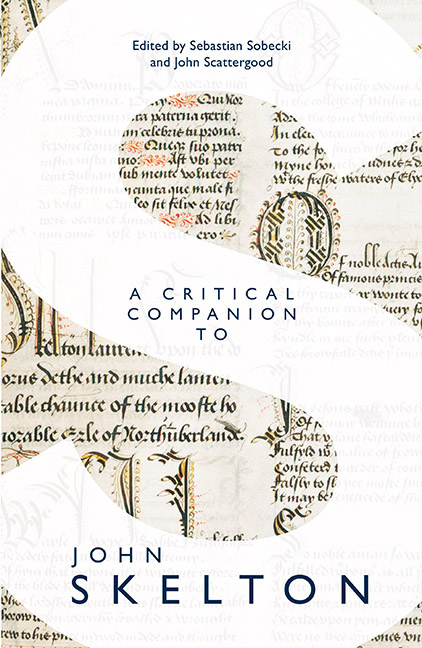Book contents
- Frontmatter
- Dedication
- Contents
- Acknowledgements
- Contributors
- Abbreviations
- Conventions
- Introduction
- 1 John Skelton (?1460–1529): A Life in Writing
- 2 Religion
- 3 Law and Politics
- 4 Classical Literature
- 5 Humanism
- 6 Satires and Invectives
- 7 Lyrics and Short Poems
- 8 Skelton's Voice and Performance
- 9 Literary Tradition
- 10 Skelton and the English Language
- 11 Skelton's English Works in Manuscripts and Print
- 12 Skelton's English Canon
- 13 Reception and Afterlife
- A Skelton Bibliography
- Index of Manuscripts
- Index of Printers and Stationers
- General Index
13 - Reception and Afterlife
Published online by Cambridge University Press: 24 July 2019
- Frontmatter
- Dedication
- Contents
- Acknowledgements
- Contributors
- Abbreviations
- Conventions
- Introduction
- 1 John Skelton (?1460–1529): A Life in Writing
- 2 Religion
- 3 Law and Politics
- 4 Classical Literature
- 5 Humanism
- 6 Satires and Invectives
- 7 Lyrics and Short Poems
- 8 Skelton's Voice and Performance
- 9 Literary Tradition
- 10 Skelton and the English Language
- 11 Skelton's English Works in Manuscripts and Print
- 12 Skelton's English Canon
- 13 Reception and Afterlife
- A Skelton Bibliography
- Index of Manuscripts
- Index of Printers and Stationers
- General Index
Summary
Skelton's afterlife is rather more complicated than his critical reception alone. That reception has been well charted, in particular by A. S. G. Edwards in his volume in the Critical Heritage series: a volume that doubles as an anthology of criticism and also, in the Introduction, an allusion index (Edwards 1981). Skelton was a poet who divided opinion from within his own lifetime, and it was not until the twentieth century that his reputation decisively recovered from Pope's sneering dismissal of him as ‘beastly Skelton’ (Edwards 1981: No. 27, p. 75). That recovery, significantly, was led not by critics but by other poets, beginning cautiously in the eighteenth century (where this study ends) but bursting into dominance with the rise of modernism. The resurgence of interest in him in turn opened the way for the emphasis in more recent decades on historicism and textual scholarship, fields where fierce disagreement is less likely to thrive. That summary, however, leaves out two of the most striking characteristics of his afterlife. One is that the verse form he invented, skeltonics, was given the link to his name, in the adjectival form ‘skeltonical’, as early as 1589, and the link has been retained ever since: a twinning of form with poet unique in English poetry (even the ‘Shakespearean sonnet’ is a much later term). As the anonymous poem Pimlyco, or Runne Red-Cap noted in 1609, there was no need to name Skelton for him to be recognised: if one
only should hys Rymes recite,
These (all would cry) did Skelton write.
(Edwards 1981: No. 17, p. 67)The other notable characteristic is that for much of the sixteenth century he was given an alternative afterlife as ‘merry Skelton’, a jestbook character who developed a career of his own, sometimes but by no means always independent of his poetry, such as again bespeaks a high measure of popular recognition. In the 1580s and 1590s, you did not need to belong to a cultural elite to know about Skelton, though what you thought you knew might vary radically depending on whether or not you were a member.
- Type
- Chapter
- Information
- A Critical Companion to John Skelton , pp. 194 - 204Publisher: Boydell & BrewerPrint publication year: 2018

